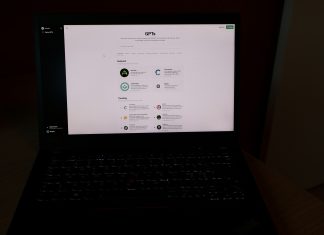When the world went into lockdown in 2020 in a bid to stop the spread of Covid-19, many companies went into a state of survival. Many were forced to furlough staff and look for loans to ensure they could weather the storm. Building a new startup might have been the last thing some would think to do during this time, but Vall Herard did just that with Saifr.
Prior to creating Saifr, Herard had been using traditional regression econometrics to help manage market and credit risk. He started playing around with the idea of doing something similar to measure and calculate compliance risk but was uncertain about the demand for this capability. “I was at a compliance conference in a room full of chief compliance officers at major financial institutions, and I asked if measuring compliance risk was something that folks would be interested in. They said ‘Yes! But, the data doesn’t exist.’ That was my lightbulb moment. There was obviously the need, and I knew where to get the data,” he said.
Soon after, the idea for Saifr was formed within Fidelity Labs, an in-house software incubator of Fidelity Investments. Fidelity had been using an internal tool for 20+ years to manage the compliance approval of marketing materials, serving as a good data source for the new platform. The Saifr team started with access to millions of documents from the work of thousands of marketing and compliance experts across various business lines. These documents, as well as others from independent sources, were validated by regulatory staff attorneys and were used to train Saifr’s natural language processing (NLP) models for addressing compliance risk. The foundation of Saifr’s AI is what sets it apart from other solutions in the market. “Our robust models detect compliance risks with greater than 90% accuracy, significantly reducing human intervention and touch points,” Herard added.
The goal of Saifr was to help marketing teams provide timely communications to their target audience while maintaining compliance. Herard explained that regulations from the SEC and FINRA do a good job of protecting investors. However, these regulations constantly evolve and a violation, even if it was a simple oversight, can have negative impacts on a business. This includes monetary penalties that can be hundreds of millions, but could also impact brand reputation, disrupt business, reduce productivity,cause revenue losses and more.
Marketing teams struggle to make timely communications with their customers as content often necessitates multiple compliance reviews until it is approved. These reviews are not quick, and various types of communications, spanning video, audio, image and text, leave compliance teams with a huge stack of reviews to complete. This is where Saifr’s NLP technology can help reduce stress.
Saifr provides marketing, legal and compliance teams with the power to reduce the burdens of marketing compliance reviews. Herard added, “Saifr helps to streamline the process of creating, reviewing, and approving compliant content. Saifr offers value to both marketing and compliance teams—value that only multiplies when both groups use our offering.”
Starting during a pandemic
Launching a solution during a pandemic, though challenging, was not a significant impediment, Herard noted. During the height of the pandemic in 2020, the company was in the ideation stage of development and funding followed in the fall. The following year was then spent building the products. Saifr went to market in 2022, when the pandemic was largely over. The company was perfectly placed to support companies coming out of survival mode.
While the pandemic wasn’t too big of a concern for Saifr, it did impact it. “The biggest challenge was building a company from scratch during the pandemic. Normally a startup environment is a small, co-located team ideating together—often in the garage or a dark basement. It is a testament to Fidelity’s technology and innovative culture that we were able to assemble the team that had never met to build the offering. This gives us confidence that we can face any other challenges that might come our way and still deliver for our clients.”
Key mistakes in marketing compliance
Marketing is a complex web that requires input from various teams. Copywriters, editors, subject matter experts, designers, videographers, legal divisions and compliance teams are just some of the departments that are involved. This creates an environment of constantly going back and forth to ensure the message is clear and engaging, but also compliant. As a result, there are a lot of mistakes that can slip through.
One of the most common missteps is not involving compliance early in the journey, Herard explained. By involving them near the beginning, it can shorten the process by quickly addressing barriers. Another problem is firms failing to use the right tools and relying on emails as the primary form of discussion between teams. “Emails going back and forth between multiple departments can easily lead to version control issues, missed comments, and risk to the organization. Tools like Saifr can ease collaboration between teams, track changes, maintain versions, and help with measurement and reporting.” The final mistake that Herard noted was with marketing teams not understanding the regulations. He urged marketers to spend time understanding the rules so they can improve their content and reduce the number of reviews needed. “A nice by-product of using AI tools like Saifr is that we help upskill employees on how to comply with regulations,” he added.
Generative AI has received a lot of hype over the past year and could add to the mistakes firms make. Many companies have already adopted the technology to help with their operations, and marketing seems like a common home for it. In fact, a report from eMarketer claimed that 46% of organisations leveraging generative AI are using it within marketing. On top of this, Gartner predicts that nearly a third of marketing messages from large organisations will be created through AI. However, Herard warned firms from racing to adopt the technology.
“Marketing teams are beginning to use AI tools to create content. Most of these tools use LLMs. No matter the type of LLM, public or private, the result is more content faster. However, if the business is in a regulated industry, the marketers are likely creating more non-compliant content faster that will only overwhelm the compliance department. That’s because most LLMs don’t know what is and isn’t compliant.” Before these LLMs can be leveraged, firms will need a layer of AI to run compliance checks. This would enable teams to keep pace with the content and reduce the risk of non complianterrors.
Where Saifr comes in
Marketing teams can leverage Saifr to gain confidence in their communications. Its AI technology can “read” text, flag any language that might not be compliant, suggest alternative wording and recommend disclosures. The platform can also cross-reference communication messages to ensure they follow brand guidelines, this includes demographics, sentiment, document readability level, and inclusive language. Herard described Saifr as the first stage of a compliance check that results in cleaner content that requires fewer subsequent reviews and allows teams to distribute content faster.
“Even if the marketing department doesn’t use Saifr, compliance can get the benefit of scanning the documents that have been submitted to score which ones are concerning. When reviewing documents, Saifr models “understand” content (text, images, audio, and video) and can flag risks, explain why the language was flagged, recommend alternative language, and suggest disclosures. Compliance teams can complete reviews more quickly and focus their time on the more complex issues.” By leveraging its technology, firms can mitigate regulatory risk, while boosting efficiency.
The RegTech company has had a strong year, with widespread adoption across various sectors and a notable partnership with Pinpoint Global Communications. The deal provides Pinpoint customers with access to the Saifr platform to help ensure compliance within their marketing campaigns. Saifr is currently exploring more partnerships with companies that are building private and public large language models and need the output to be compliant with industry rules and regulations.
As Saifr gears up for an ambitious period of growth, Herard outlined what makes it the best partner. “Companies that want to reduce friction in their process of creating and approving compliant content, get content into market faster, or reduce their compliance risk should consider working with Saifr.”
Saifr was recently named in the latest edition of the RegTech100. Check out the full list here for more interviews and company profiles.
Keep up with all the latest FinTech news here.
Copyright © 2023 FinTech Global
Copyright © 2018 RegTech Analyst






